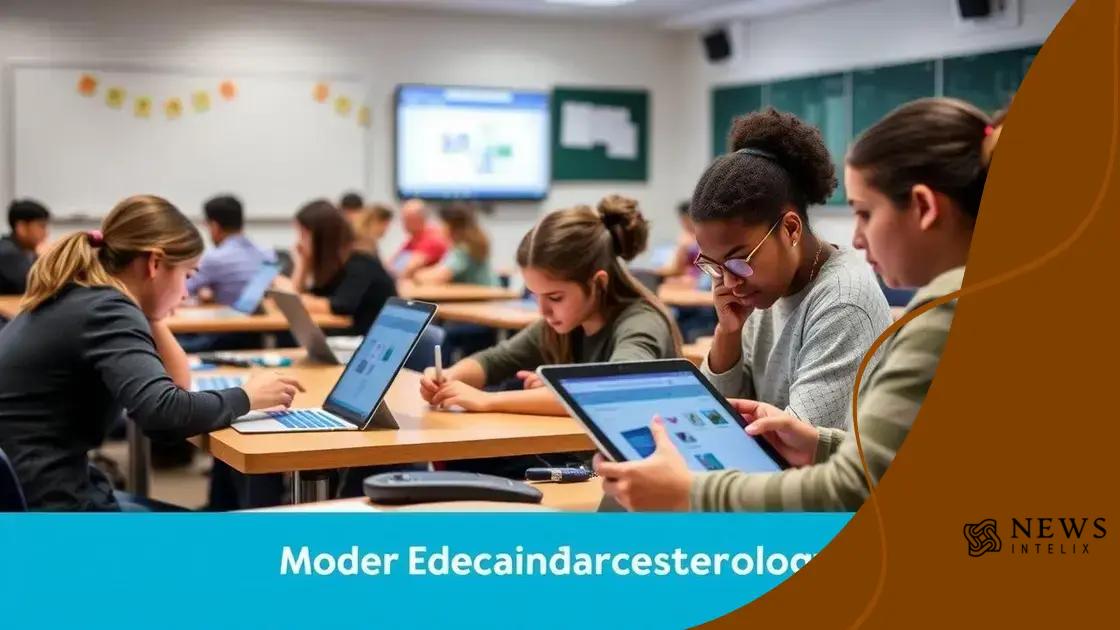Digital textbooks replace print: an educational shift

Digital textbooks replace print resources in education, offering interactive and engaging materials that enhance learning while addressing challenges like screen fatigue and technology access.
Digital textbooks replace print in many classrooms, transforming how students access information. Curious about this shift? Let’s explore the benefits and implications for education.
The evolution of digital textbooks
The evolution of digital textbooks has significantly changed the landscape of education. These resources have transformed the way students and teachers interact with learning materials. By integrating technology into the classroom, education is becoming more accessible and engaging.
Initially, digital textbooks were simply online versions of their printed counterparts. Over time, however, they have evolved beyond that basic function. Today, they incorporate multimedia elements such as videos, interactive quizzes, and hyperlinks that enhance the learning experience.
Key Features of Modern Digital Textbooks
Modern digital textbooks encompass various features that make them appealing in the educational setting. These features include:
- Interactive content: Students can engage with lessons through videos and interactive exercises.
- Accessibility: Digital textbooks can be accessed on various devices, making them available anywhere, anytime.
- Cost-effective: In many cases, digital textbooks are less expensive than traditional printed ones.
- Up-to-date information: Digital textbooks can be easily updated to reflect the latest knowledge and discoveries.
With the rise of technology, schools and universities have started to embrace digital formats more widely. Many institutions are now integrating these resources into their curricula, allowing for a more dynamic learning process. However, it hasn’t been without challenges. Educators and students alike have faced obstacles related to screen fatigue and the need for reliable internet access. Yet, the benefits often outweigh these hurdles.
As we continue to explore the world of digi…
Advantages of digital over print textbooks
The advantages of digital textbooks over print are becoming increasingly clear as technology advances. With their interactive nature and accessibility, these tools are transforming how students learn.
One major benefit is the cost-effectiveness of digital formats. Schools can save money by opting for eBooks instead of printed copies. Additionally, students often find that electronic resources contain a wealth of information that can be updated quickly and efficiently.
Enhanced Learning Experience
Digital textbooks offer features that enhance the learning experience significantly. For instance:
- Multimedia integration: Students can watch videos and listen to audio clips directly within their textbooks.
- Interactive quizzes: Many digital resources include quizzes that allow students to test their knowledge instantly.
- Storage and portability: Instead of carrying heavy books, students can access all their materials on a single device.
- Search functionality: Quick searches can help students find information without flipping through pages.
These features foster a more engaging and interactive learning environment. As schools incorporate digital textbooks into their curricula, students are discovering more dynamic ways to absorb material. Moreover, the integration of technology in education prepares students for a future where digital skills are essential.
While print textbooks have their place, the numerous benefits of digital resources highlight a shift in educational methodologies. As educators embrace these tools, it becomes clear that the future of learning is headed toward digital formats.
How schools are adopting digital formats

Schools are rapidly adopting digital formats for textbooks, making the switch from traditional print resources. This transition is driven by the need for more engaging and flexible learning environments.
One way schools are embracing this change is through vendor partnerships that provide digital content. Many educational publishers offer discounts and bundles to schools, making it easier to transition to digital resources. Teachers are encouraged to attend training sessions on how to utilize these new tools effectively.
Implementing Digital Resources
To successfully implement digital formats, schools are taking several steps:
- Infrastructure upgrades: Many schools invest in improved Wi-Fi and hardware to support digital learning.
- Teacher training: Professional development programs are essential for helping teachers integrate digital formats into their classes.
- Student feedback: Schools often gather input from students about their experiences, allowing for continuous improvement.
The shift to digital formats also involves changing the mindset of both teachers and students. Educators are learning to blend traditional teaching methods with technology, while students are becoming more adaptable in their learning approaches. As schools incorporate digital textbooks into their classrooms, they are also encouraging collaborative learning through group projects and discussions facilitated by technology.
This ongoing evolution not only facilitates a more dynamic educational atmosphere but also prepares students for a world where digital literacy is essential. By embracing digital formats, schools are ensuring they remain relevant and effective in meeting the needs of today’s learners.
Challenges faced by digital textbooks
While digital textbooks offer many advantages, there are several challenges that schools and students face during this transition. Understanding these obstacles is essential for making the most of digital resources.
One significant challenge is screen fatigue. Students often find it tiring to read from screens for extended periods. This can lead to decreased concentration and engagement. To combat this, schools are encouraging regular breaks and using a mix of digital and traditional resources.
Common Challenges with Digital Textbooks
There are various issues schools encounter when implementing digital formats:
- Access to technology: Not every student has access to a device or reliable internet at home, which can create disparities in learning.
- Training for teachers: Many educators need proper training to effectively integrate digital textbooks into their teaching methods.
- Content updates: Keeping digital resources updated can be challenging, especially if schools rely on third-party vendors.
- Screen time regulations: Parents and educators often worry about the amount of time students spend on screens.
In addition to these challenges, there is also the issue of digital distractions. With devices, students may find it easy to access social media or games, which can detract from their focus on learning materials. As a result, maintaining student engagement becomes more difficult.
Teachers and schools are working to create strategies that address these challenges. This may include setting clear expectations about device usage during class and integrating more interactive elements in digital resources to capture student interest. By recognizing and addressing these hurdles, the success of digital textbooks can be significantly improved.
Future trends in digital educational resources
The future of digital educational resources is rapidly evolving, promising enhancements that will make learning even more engaging and effective. As technology continues to advance, several key trends are emerging that will shape the next generation of educational materials.
One significant trend is the integration of artificial intelligence in digital textbooks. AI can personalize learning experiences, adapting content to meet individual student needs. This means that each student can have a tailored educational journey, maximizing their strengths and addressing their weaknesses.
Emerging Trends in Digital Education
Several exciting trends are developing in the field of digital textbooks and educational resources:
- Gamification: Incorporating game-like elements into learning can boost motivation and engagement, turning study sessions into fun activities.
- Augmented and Virtual Reality: AR and VR technologies will create immersive learning environments where students can explore concepts in a virtual space.
- Cloud-Based Resources: With improved internet access, cloud-based educational tools will allow students to collaborate and access materials from anywhere.
- Data Analytics: Schools will utilize data analytics to track student performance, gaining insights that can improve curriculum and teaching strategies.
Furthermore, the increased use of mobile devices in education is driving the demand for resources that are accessible on various platforms. Students can learn on-the-go, using apps and digital textbooks that fit their busy schedules. This flexibility is vital in a fast-paced world.
As these trends continue to unfold, schools will need to adapt and be open to change. The landscape of education is set to evolve dramatically, driven by advancements in technology and innovative approaches to learning.
FAQ – Frequently Asked Questions About Digital Textbooks
What are digital textbooks?
Digital textbooks are electronic versions of traditional books that can include interactive features such as videos, quizzes, and links.
How do digital textbooks enhance learning?
They provide a more engaging and interactive experience, often incorporating multimedia elements that cater to different learning styles.
What challenges do students face with digital textbooks?
Students may experience screen fatigue, distractions from their devices, and issues with access to technology.
What trends are shaping the future of digital educational resources?
Emerging trends include the use of artificial intelligence for personalized learning, gamification, and virtual reality experiences in education.
